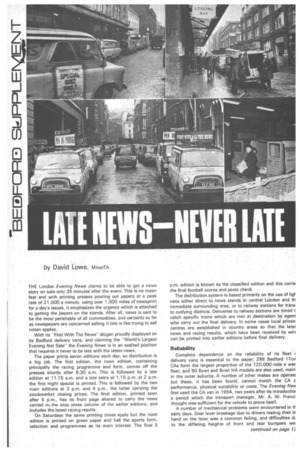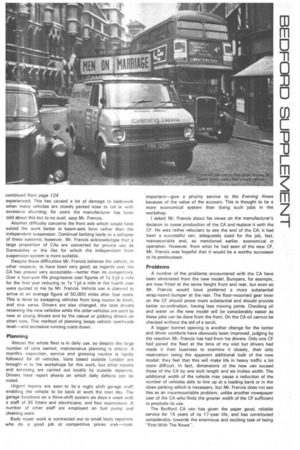by David Lowe, MInstTA
Page 126

Page 131

If you've noticed an error in this article please click here to report it so we can fix it.
THE London Evening News claims to be able to get a news story on sale only 35 minutes after the event. This is no mean feat and with printing presses pouring out papers at a peak rate of 21,000 a minute, using over 1,000 miles of newsprint for a day's issues, it emphasizes the urgency which is attached to getting the tiapers on the stands. After all, news is said to be the most perishable of all commodities, and certainly so far as newspapers are concerned selling it late is like trying to sell rotten apples.
With its "First With The News" slogan proudly displayed on its Bedford delivery vans, and claiming the "World's Largest Evening Net Sale" the Evening News is in an exalted position that requires it never to be late with the latest news.
The paper prints seven editions each day, so distribution is a big job. The first edition, the noon edition, containing principally the racing programme and form, comes off the presses shortly after 9.30 a.m. This is followed by a late edition at 11.15 a.m. and a late extra at 1.15 p.m. at 2 p.m. the first night special is printed. This is followed by the two main editions at 3 p.m. and 4 p.m., the latter carrying the stockmarket closing prices. The final edition, printed soon after 5 p.m., has its front page altered to carry the news carried in the stop press column of the earlier editions, and includes the latest racing results.
On Saturdays the same printing times apply but the noon edition is printed on green paper and ha the sports form, selection and programmes as its main interest. The final 5 p.m. edition is known as the classified edition and this carrie the final football scores and pools check.
The distribution system is based primarily on the use of ligh vans either direct to news stands in central London and th immediate surrounding area, or to railway stations for trans to outlying districts. Deliveries to railway stations are timed t catch specific trains Which are met at destination by agent who carry out the final delivery. In some cases local printin centres are established in country areas so that the latet news and racing results, which have been received by will can be printed into earlier editions before final delivery.
Reliability Complete dependence on the reliability of its fleet delivery vans is essential to the paper; 286 Bedford 17cv CAs form the largest proportion of the 120,000-mile a weE fleet, and 50 6cwt and 8cwt HA models are also used, mainl in the outer suburbs. A number of other makes are operate but these, it has been found, cannot match the CA c performance, physical suitability or costs. The Evening Nevi first used the CA van in 1954, two years after its introductioi a period which the transport manager, Mr. A. W. Franci thought was sufficient for the vehicle to prove itself. A number of mechanical problems were encountered in ti early days. Gear lever breakage due to drivers resting their 1€ hand on the lever was a common failing, and difficulties dt to the differing. heights of front and rear bumpers we
experienced. This has caused a lot of damage to bodywork when many vehicles are closely parked nose to tail or with excessive shunting; for years the manufacturer has been told about this but to no avail, says Mr. Francis.
Another difficulty concerns the front axle which would have suited the work better in beam-axle form rather than the independent suspension. Continual kerbing leads to a collapse of these systems; however, Mr. Francis acknowledges that a large proportion of CAs are converted for private use as Dormobiles or the like for which the independent front suspension system is more suitable.
Despite these difficulties Mr. Francis believes the vehicle, in other respects, to have been very good; as regards cost the CA has proved very acceptable—better than its competitors. Over a four-year life progressive cost figures of is 51d a mile for the first year reducing to is 1 fd a mile in the fourth year were quoted to me by Mr. Francis. Vehicle use is planned to arrive at an average figure of 50,000 miles after four years. This is done by swapping vehicles from long routes to short, and vice versa. Drivers are also changed, the best drivers receiving the new vehicles while the older vehicles are used by new or young drivers and by the casual or jobbing drivers on short rims. This method of planning keeps vehicle overheads level—and excessive running costs down.
Planning Almost the whole fleet is in daily use, so despite the large number of vans owned, maintenance planning is critical. A monthly inspection, service and greasing routine is rigdly followed for all vehicles. Vans based outside London are brought in to the workshops for this work, but other repairs and servicing are carried out locally by outside repairers. Drivers have report sheets on which daily defects can be noted.
Urgent repairs are seen to by a night shift garage staff, enabling the vehicle to be back at work the next day. The garage functions on a three-shift system six days a week with a staff of 36 fitters and electricians, and four supervisors. A number of other staff are employed on fuel pump and cleaning work.
Body repair work is contracted out to small body repairers who do a good job at competitive prices and—most important—give a priority service to the Evening News because of the value of the account. This is thought to be a more economical system than doing such jobs in the workshop.
asked Mr. Francis about his views on the manufacturer's decision to cease production of the CA and replace it with the CF. He was rather reluctant to see the end of the CA; it had been a successful van, adequately sized for the job, fast, manoeuvrable and, as mentioned earlier, economical in operation. However, from what he had seen of the new CF, Mr. Francis was hopeful that it would be a worthy successor to its predecessor.
Problems
A number of the problems encountered with the CA have been eliminated from the new model. Bumpers, for example, are now fitted at the same height front and rear, but even so Mr. Francis would have preferred a more substantial wrap-round bumper at the rear. The floor-mounted gear lever on the CF should prove more substantial and should provide better co-ordination, having less moving joints. Checking oil and water on the new model will be considerably easier as these jobs can be done from the front. On the CA oil cannot be checked without the aid of a torch.
A bigger bonnet opening is another change for the better and driver comforts have obviously been improved, judging by the reaction Mr. Francis has had from his drivers. Only one CF had joined the fleet at the time of my visit but drivers had made it their business to examine it closely, their only reservation being the apparent additional bulk of the new model; they feel that this will make life in heavy traffic a bit more difficult. In fact, dimensions of the new van exceed those of the CA by one inch length and six inches width. The additional width of the vehicle may cause a reduction of the number of vehicles able to line up at a loading bank or in the close parking which is necessary, but Mr. Francis does not see this as an insurmountable problem, unlike another newspaper user of the CA who finds the greater width of the CF sufficient to preclude its use.
The Bedford CA van has given the paper good, reliable service for 15 years of its 17-year life, and has contributed considerably towards the enormous and exciting task of being "First With The News".














































































































































































































